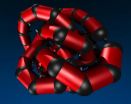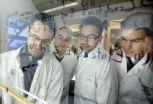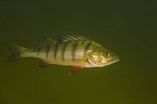(Press-News.org) University of Cincinnati-led research takes a new direction in examining the availability of healthy foods for urban populations by examining the commuting patterns of its residents.
This new approach to identifying so-called food deserts, now published online, will appear in the May journal of Health and Place.
Neighborhoods without access to stores that provide healthy food options – such as fresh fruits and vegetables – are often labeled as food deserts. However, current methods for determining which neighborhoods have access to nutritious foods focus only on where residents' homes are located, and not where people move through the course of the day.
In an article led by Michael Widener, a UC assistant professor of geography, researchers calculated a new way to pinpoint food deserts by factoring the commuting patterns of residents.
Focusing their examination on Cincinnati and using transportation data from The Ohio-Kentucky-Indiana Regional Council of Governments (OKI), they found that residents in certain transportation analysis zones had better access to supermarkets, thanks to their commutes, compared with just factoring in locations of homes.
In other words, some people who reside in food deserts could still pick up healthy foods like fruits and vegetables on their way home from work, as their access to supermarkets increases because of their other daily travel plans.
The paper also points to an American Community Survey which found that 71 percent of workers 16 and older in Cincinnati are lone commuters to work. However, the current study did not identify whether commuters who resided in food deserts were actually purchasing the healthier foods carried by supermarkets.
Food deserts are often associated with low-income neighborhoods, which have been linked to a range of health problems, including increased risk of diabetes and stroke. However, the authors report that previous research has not produced a consistent link between access to healthy food and healthier residents.
The authors suggest that by using this new method of locating food deserts, new intervention strategies could be developed to encourage post-work trips for healthier food options.
"Given the daily movements of an urban population, this novel measure can provide new information to public and transportation policy makers seeking to understand the role spatial access to healthy food plays in population health," states the article.
The OKI data that was studied on the Cincinnati-proper region was from 2005, the most recent year available. Researchers used 2012 data to examine locations of national and regional grocery stores and supermarkets in comparison to Cincinnati neighborhoods. The study covered 359 transportation analysis zones in Cincinnati and approximately 158,000 automobile commuters.
Although the researchers focused on automobile commuters for this study, future research is under way in factoring populations taking public transportation.
###Steven Farber, assistant professor of geography at the University of Utah; Tijs Neutens, a post-doctoral researcher for the Department of Geography at Ghent University; and Mark W. Horner, associate professor of geography at Florida State University, were additional authors on the study.
Health and Place is an international journal published by Elsevier, dedicated to the study of all aspects of health and health care in which place or location matters.
UC research takes a new approach to identifying 'food deserts'
2013-02-15
ELSE PRESS RELEASES FROM THIS DATE:
Nano-machines for 'bionic proteins'
2013-02-15
This press release is available in German.
Physicists of the University of Vienna together with researchers from the University of Natural Resources and Life Sciences Vienna developed nano-machines which recreate principal activities of proteins. They present the first versatile and modular example of a fully artificial protein-mimetic model system, thanks to the Vienna Scientific Cluster (VSC), a high performance computing infrastructure. These "bionic proteins" could play an important role in innovating pharmaceutical research. The results have now been published in ...
Study finds possible link between diabetes and increased risk of heart attack death
2013-02-15
Having diabetes doubles a person's risk of dying after a heart attack, but the reason for the increased risk is not clear. A new University of Iowa study suggests the link may lie in the over-activation of an important heart enzyme, which leads to death of pacemaker cells in the heart, abnormal heart rhythm, and increased risk of sudden death in diabetic mice following a heart attack.
"Many studies have shown that patients with diabetes are at especially high risk for dying from a myocardial infarction (heart attack). Our study provides new evidence that this excess ...
Wild plants are infected with many viruses and still thrive
2013-02-15
UNIVERSITY PARK, PA. -- Researchers have studied viruses as agents of disease in humans, domestic animals and plants, but a study of plant viruses in the wild may point to a more cooperative, benevolent role of the microbe, according to a Penn State virologist.
"Most of these wild plants have viruses," said Marilyn Roossinck, professor of plant pathology and environmental microbiology and biology, who has examined more than 7,000 individual plants for viruses. "But they don't have any of the symptoms that we usually see in crop plants with viruses."
Most of the viruses ...
Technique that removes additional toxins prolongs dialysis patients' lives
2013-02-15
Highlights
A technique that removes additional toxins during dialysis decreased kidney failure patients' risk of dying from any cause by 30% over three years.
The technique also reduced patients' risk of dying from heart-related causes or infections.
15% to 25% of dialysis patients die annually.
Washington, DC (February 14, 2013) — A technique that removes additional toxins during dialysis may prolong kidney failure patients' lives, according to a clinical trial appearing in an upcoming issue of the Journal of the American Society Nephrology (JASN). In light of ...
Accelerated protons confirm origin of cosmic rays
2013-02-15
We are constantly being bombarded by speedy, energetic, and yet unassuming, particles called cosmic rays. These charged particles (mostly protons), continuously assail the Earth from outer space. There is general consensus among scientists that supernova remnants (the leftovers of a supernova explosion) are the sources of cosmic rays, but the final proof has been elusive since cosmic rays are deflected on their way from the source to Earth.
A new study offers conclusive evidence that cosmic ray protons within our galaxy are accelerated in the shock waves produced by ...
Fish become bolder and more gluttonous from drug residue
2013-02-15
Anxiety-moderating drugs that reach waterways via wastewater create fearless and asocial fish that eat more quickly than normal. These behavioral changes can have serious ecological consequences. This is shown by Umeå University researchers in the prestigious journal Science.
Many drugs leave our bodies unaffected, and residues from them are therefore found in wastewater. Low concentrations of drugs are often found downstream from sewage treatment plants. Today we test how dangerous drugs are to humans, but our knowledge of the environmental impacts of drugs is limited. ...
Mood-modifying drugs for humans also alter fish behavior
2013-02-15
Pharmaceutical drugs that end up in the world's waterways after being excreted, flushed and treated at wastewater treatment plants may lead to unexpected ecological impacts, according to a new study of wild European perch. Tomas Brodin and colleagues from Umeå University in Sweden discovered that the fish ate faster, became bolder and acted less social after being subjected to an anxiety-moderating drug, known as Oxazepam.
The psychiatric drug is used to treat anxiety in humans. But, Oxazepam residues often wind up in natural aquatic systems, downstream from sewage treatment ...
Proof: Cosmic rays come from exploding stars
2013-02-15
Menlo Park, Calif. — A new study confirms what scientists have long suspected: Cosmic rays – energetic particles that pelt Earth from all directions – are born in the violent aftermath of supernovas, exploding stars throughout the galaxy.
A research team led by scientists at the Kavli Institute for Particle Astrophysics and Cosmology at the Department of Energy's (DOE) SLAC National Accelerator Laboratory sifted through four years of data from NASA's Fermi Gamma-ray Space Telescope to find the first unambiguous evidence of how cosmic rays are born.
Reporting in the ...
Rapid changes in the Arctic ecosystem during ice minimum in summer 2012
2013-02-15
This press release is available in German.
Bremerhaven, 14 February 2013. Huge quantities of algae are growing on the underside of sea ice in the Central Arctic: in 2012 the ice algae Melosira arctica was responsible for almost half the primary production in this area. When the ice melts, as was the case during the ice minimum in 2012, these algae sink rapidly to the bottom of the sea at a depth of several thousands of metres. Deep sea animals such as sea cucumbers and brittle stars feed on the algae, and bacteria metabolise what's left, consuming the oxygen in the ...
Study of insomnia finds a new predictor for suicidal thoughts
2013-02-15
DARIEN, IL – A new study confirms a link between insomnia and thoughts of suicide and suggests that this relationship is mediated by dysfunctional beliefs and attitudes about sleep as well as nightmares. The study suggests that the targeted assessment and treatment of specific sleep problems may reduce the risk of suicide in people with depressive symptoms.
"Insomnia and nightmares, which are often confused and go hand-in-hand, are known risk factors for suicide but just how they contribute was unknown," said Dr. W. Vaughn McCall, the study's lead author and chair of ...



